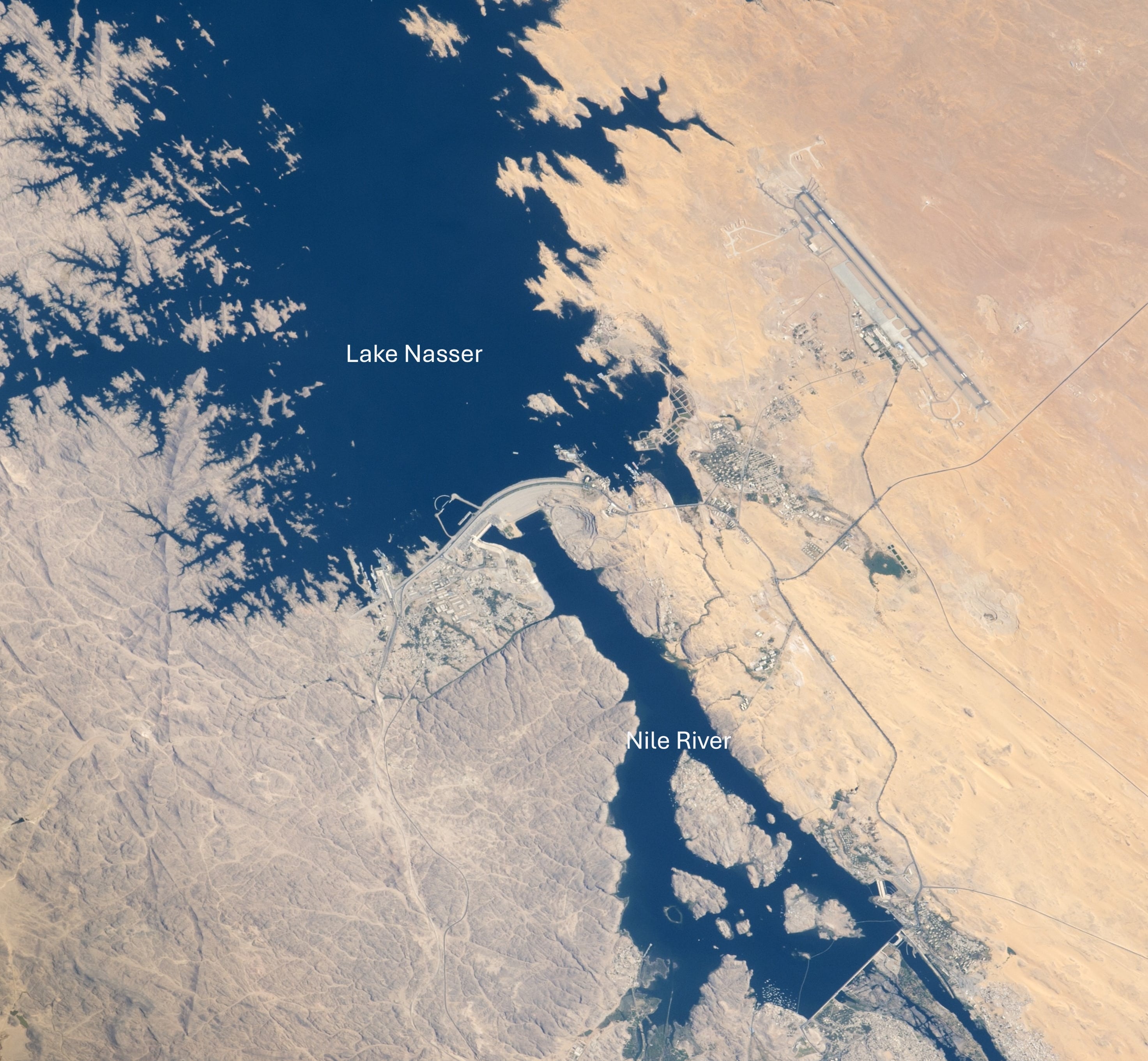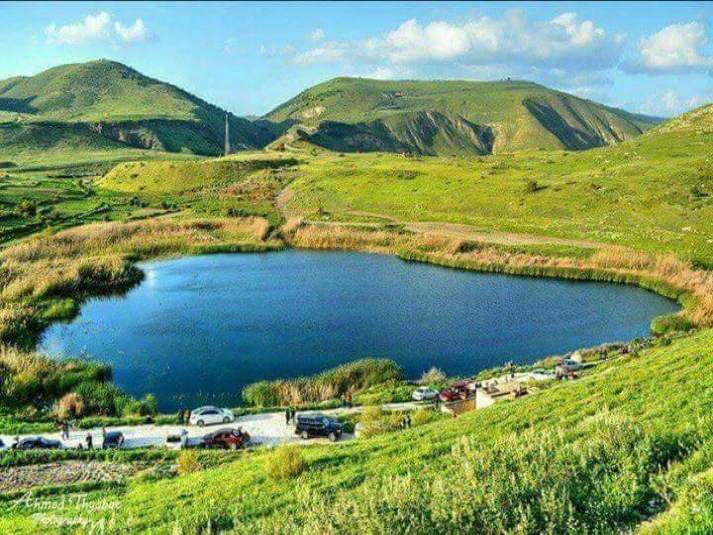Egypt
- country brief description:
"Egypt is located in Northeast Africa at the junction with the Asian continent, it is bordered by the Mediterranean and the Red Sea, and about 90% of its surface area is covered by desert lands."
- Image introduction:

- Introduction:
Brief description
Egypt is located in Northeast Africa. While most of the country is located on the African continent, the Sinai Peninsula is part of the Asian continent. Its maritime borders are the Mediterranean Sea in the North and the Red Sea in the East, both seas are connected through the Suez Canal. About 90% of the territory is covered by desert lands: 22% by the Eastern desert and 68 % by the Western desert (Central Agency for Public Mobilization and Statistics, 2016).
Egypt is an arid country, the climate is dry, hot and desertic. The annual precipitation is very low and mostly received on the coastal area. The challenge of water resource availability originates from a high evaporation rate and the absence of permanent surface water in large parts of the territory (World Bank, 2021).
The River Nile is the largest body of freshwater in the region, and it is shared amongst 12 countries. Egypt is entirely dependent on it to cover over 70% of the country’s water needs. The Nile Valley and Delta make up for 4% of the territory and contain the majority of the country’s population. Groundwater can be found in the Western Desert and Sinai regions. However, the aquifers are for the most part deep and non-renewable. In addition, the great depth and deterioration in quality make the groundwater resources very difficult to use. Water demand comes mainly from agriculture, domestic and industry sectors (Egypt, 2023).
The priorities for the water sector are integrated in the National Water Resources Plan created in 2005. The National Focal Point in Egypt is the Ministry of Water Resources and Irrigation (MWRI).
Image: Satellite View of Aswan High Dam, Egypt © NASA Earth Observatory, 2015.
Legal Framework
Until 2021, the main water law was Law number 12 of 1984 “concerning the Issue of the Law on Irrigation and Drainage”. It defined the National policy on Irrigation and Drainage with a focus on public properties (i.e. the River Nile, main canals, drains and embankment), groundwater and drainage water, as well as flooding and coastal protection. This law also regulated water allocation and farmland irrigation.
Law 12/1984 was repealed by Law number 147 of 2021 “concerning the Issue of the Law on Water Resources and Irrigation”. It contains 10 chapters and 126 articles. It
It defines the principles and rules relating to water resources use, management, and sustainable development. It sets rules about water administration, distribution, irrigation, and drainage systems. The aim is to achieve the rational use of groundwater to preserve it for future generations and improve developing and using modern irrigation systems in agricultural lands.
The law establishes the protection the course of the Nile Rive and covers groundwater issues such as well drilling, usage rates for irrigation and the disposal of wastewater resulting from desalination. It also covers the protection of resources, water facilities, and beaches, in particular the dangers of rising water levels, of rain and floods, and it prohibits any work that affects the natural path line of the Egyptian shores.
Two more laws complete Egypt’s water legislation:
1/ Law number 48 of 1982 “concerning Pollution Protection of the River Nile and the Water Channels”. The 20 articles establish the protection of fresh and non-freshwater channels forbidding wastewater and fuel discharge, and regulating pesticide and herbicide use as well as water reuse from water channels.
2/ Law number 4 of 1994 “‘Promulgating the Environment Law and its Executive Regulation” which defines regulations for environmental protection including air, land and water. Water protection covers Egyptian coastal shores and adjoining waters.
The National Water Resources Plan (NWRP) was established in 2005 for the period 2005-2017. An update was announced by the Ministry of Water and Irrigation in 2018 for the 2017-2035 period. As of 2025, an update for a strategy to 2050 is in development.
In contrast with previous legislation the NWRP 2017 does not aim for increased Nile water use for irrigation, but provides goals towards water use efficiency, drainage water and treated wastewater use, and improved water demand management at local level.
The National Water Resources Plan’s main objectives are the following:
- Economic and social development: increase employment, improve water equity in distribution and farmers income, attain the minimum level of food self-sufficiency.
- Service improvement: meet water needs in all sectors, protect public health and the environment, strengthen institutional water framework and recover operational and maintenance costs.
- Implementation: create coordination mechanisms between stakeholders, monitor and evaluate water sector programmes’ implementation and contribute to the water section of the National Investment Plans.
The NWRP project has also endeavoured to create the necessary coordination mechanisms to develop consensus on the objectives and implementation of the NWRP between all stakeholders involved.
It also aims to develop the capacity to monitor and evaluate the implementation of the Water Sector programs and provides inputs for the water component of the National Investments Plans.
Main Institutions
The missions of developing, distributing and managing the water resources are the responsibility of the Ministry of Water Resources and Irrigation (MWRI). The MWRI is also in charge of the development, operations and maintenance of associated water works as well as the collection and disposal of agricultural drainage water, the monitoring and assessment of water quality, and the protection of the coastal lakes and the shoreline. Within the MWRI, the Egyptian Public Authority for Drainage Projects (EPADP) is in charge of all drainage activities including reuse of drainage water.
Additionally, the National Water Research Centre (NWRC) is the research arm of the MWRI. It consists of 12 research institutes, a Central Laboratory for Environment Quality Monitoring (CLEQM) and the Strategic Research Unit (SRU)
The Ministry of Agriculture and Land Reclamation (MALR) is tasked with improving agricultural activities and land reclamation, including water management at the on-farm level. In accordance with farmers inputs, the MALR and its research centres conduct work towards improving farm output per unit of water and land. The MALR also sets land reclamation and horizontal expansion policies, in alignment with the NWP. The appointed department within MALR is the Central Administration for Soils and Water.
The Ministry of Housing, Utilities and New Communities (MHUNC), provides water supply and sanitation services to the municipal and industrial subsectors It is implementing national programs to expand municipal water treatment capacity and provide adequate sanitation facilities. Within the MHUNC, the National Organization for Potable Water and Sanitary Drainage (NOPWASD), and its affiliated agencies, are responsible for the planning, design and oversight of construction of municipal drinking water purification plants, distribution systems, sewage collection systems, and municipal wastewater treatment.
In addition, the Holding Company for Water and Wastewater (HCWW) is in charge of the operation, maintenance and distribution of drinking water facilities as well as the collection and treatment of wastewater. Moreover, the Drinking Water, Sanitation and Consumer Protection Regulatory Agency (EWRA) is the quality supervising body for the drinking water, sanitation and wastewater sectors. Finally, the Construction Authority for Potable Water and Wastewater (CAPW) is the executive body for drinking water and sanitation sectors.
|
Area of expertise |
Water resource management |
Drinking water supply |
Sanitation |
Irrigation |
|
Responsible authority |
||||
|
Ministry of Water and Irrigation |
☑ |
☑ |
||
|
Ministry of Agriculture and Land Reclamation |
☑ |
|||
|
Ministry of Housing, Utilities and Urban Communities |
☑ |
☑ |
||
|
EPADP |
☑ |
|||
|
Egyptian Public Authority for the High Dam and Aswan Reservoir |
☑ |
|||
|
NOPWASD |
☑ |
☑ |
||
|
EWRA |
☑ |
☑ |
||
|
HCWW |
☑ |
☑ |
||
|
CAPW |
☑ |
☑ |
||
|
Central Administration for Soils and Water |
☑ |
The territorial water management
The 2021 Water Resources and Irrigation Law provides updated information on the role of Water User Associations (WUAs) and the development and improvement of irrigation and drainage systems. WUAs are not-for-profits with independent legal personalities, licensed by a Ministerial decree. Their objectives strengthen and enhance collaboration between users and the MWRI in managing, developing, and enhancing irrigation and drainage systems. WUAs consolidate the principle of community participation by establishing associations for water users at all levels and involving them in the process of managing the water system.
Climate change adaptation actions for the water sector
According to Egypt’s Second Updated Nationally Determined Contribution of 2023, water resources and irrigation actions will concern the challenges to be faced by the Nile River in terms of decreasing and increasing water flows due to climate change and flash flooding. These actions cover multisectoral water conservation measures, non-conventional water resources use, extended agricultural drainage and treated wastewater reuse, and consolidated transboundary cooperation with Nile Basin countries.
Main issues in Water Resource Management
Egypt is a developing country with a fast-growing population of which the overwhelming majority lives in either in the Nile Valley or the Nile Delta.
Current and predicted water availability data shows that such demographic growth puts additional pressure on water resources and accelerates the country’s trend towards severe water scarcity. In addition, Egypt’s water stress level is worsened by climate change, pollution and geopolitical stakes (Egypt, 2023).
In particular, the Nile Delta is one of three megadeltas in the world characterised by extreme vulnerability due to rising sea-level trends caused by climate change by 2050. Consequences include population displacement, saltwater intrusion, reduced recharge rates and higher evaporation rates all leading to reduced freshwater availability in addition to reduced land availability impacting food production (Nicholls et al. – IPCC, 2007).





